Episkopi (Mesa Gonia)
The most important Byzantine monument on the island
The most important Byzantine monument on the island
Episkopi or Mesa Gonia (Mesa Gonia means Inner Corner) is 6 km away from Fira, near Exo Gonia and Kamari.
The settlement suffered extensive damage in the 1956 earthquake, and was subsequently abandoned by its people, who moved to Kamari. It was known for its wine production and had several wineries; today, you can visit those of Argyros and Roussos.
The settlement is illustrated by Olivier on a 1801 map of Santorini. Before the 1956 earthquake it had churches and mansions. The winery of Mosiniore (Catholic Bishop of Santorini) was an interesting one. It was a large structure with six domes in line. Episkopi Gonia suffered extensive damage during this earthquake, and that’s why the residents abandoned it and settled on the beach where today’s settlement of Kamari stands.
The village was known for its wine production and it had wineries two of which you can visit, Estate Argyros and Roussos. It is worth walking the path which starts in front of the Estate Argyros winery and admire the narrow cobblestone roads and the old houses with their yards full of flowers. Some of them have been restored.
The most important attraction in the village is the Byzantine church of Koimisi tis Theotokou (the Assumption of Virgin Mary), or Panagia Episkopi, or Kira Piskopis, and that is why the village is also called Episkopi Gonia. It is the most important Byzantine monument on the island. The initial church was a three-aisled early Christian basilica and was transformed into a cruciform church. Later on, two chapels were added.
According to Mrs Maria Louisa Priovolou-Danezis *, the Emperor of Byzantium Alexios I Comnenos (1081-1118) is acknowledged as the founder and donor of the church, which was perhaps the Katholikon of a monastery. The interior of Episkopi was decorated with wall painting, most probably commissioned by the Emperor, but during the Othoman Rule they were covered with plaster. Some wall paintings have been cleaned and revealed. Judging from the quality of the paintings of the ensamble preserved, these can be characterized as provincial works in a folk vein. The figures in the representations of the Resurrection of Christ and the Dormition of the Virgin (Koimisis) are reminiscent of wall paintings in Cappadokia. Anastasios Orlandos proposed that the painter was of Eastern provenance, and dated them in 1100. It is the first type of church with a cruciform dome covered with byzantine tiles, built on the island.
* The detailed text is included in the book “Santorini: Thera, Therasia, Aspronisi, Volcanos”, by Ioannis Danezis/2001, Editor Emm.A. Lignos.

Από ασφαλτωμένο δρόμο 3 χλμ. που οδηγεί και στην Κόκκινη παραλία (υπάρχει σήμανση λίγο πριν μπείτε στον οικισμό) θα πάτε στο ακρωτήριο που ορίζει το δυτικότερο άκρο του νησιού, όπου δεσπόζει ο φάρος. Την ώρα του ηλιοβασιλέματος θα απολαύσετε ένα θέαμα μοναδικό.
Ο φάρος του Ακρωτηρίου είναι ένας από τους ωραιότερους των Κυκλάδων. Κατασκευάστηκε το 1892 από τη Γαλλική Εταιρεία Φάρων. Το ύψος του πύργου του είναι 10 μέτρα. Ανακαινίστηκε το 1925, διέκοψε τη λειτουργία του στον Β΄Παγκόσμιο πόλεμο και άρχισε να λειτουργεί πάλι το 1945. Ηλεκτροδοτήθηκε το 1983 και έγινε αυτόματος το 1988. Νότια του φάρου υπάρχει αγκυροβόλιο προστατευμένο από τους βόρειους ανέμους.

